Category: Recommended Reading
The Art Of Adam Elsheimer And The Dawn Of Modern Science
Michael Prodger at Literary Review:
 Contemporary accounts suggest that Elsheimer was an attractive personality but ‘very solitary and contemplative’: walking through the streets, ‘he would be so caught up in thought that he would not say anything to anyone unless they spoke to him first’. He was also a perfectionist and an achingly slow worker, traits which led to his imprisonment for debt, since he could not bring himself to churn out works to satisfy his ready market. Incarceration did not spur greater productivity but exacerbated his pre-existing depression.
Contemporary accounts suggest that Elsheimer was an attractive personality but ‘very solitary and contemplative’: walking through the streets, ‘he would be so caught up in thought that he would not say anything to anyone unless they spoke to him first’. He was also a perfectionist and an achingly slow worker, traits which led to his imprisonment for debt, since he could not bring himself to churn out works to satisfy his ready market. Incarceration did not spur greater productivity but exacerbated his pre-existing depression.
Elsheimer, as one of his circle put it, ‘grasped Nature’s spirit and essence’. His paintings, says Bell, are products of the shift in the natural sciences to greater objectivity. Elsheimer moved in a circle that contained the collector and papal botanist Johannes Faber and the Accademia dei Lincei, a group of empiricists with Galileo at its heart. He was familiar with current intellectual enquiries, put his eye to one of the first telescopes and was an expert in herbal medicine.
more here.
Sunday, May 21, 2023
Reading Vasily Grossman While Waiting for S
Maria Tumarkin in the Sydney Review of Books:
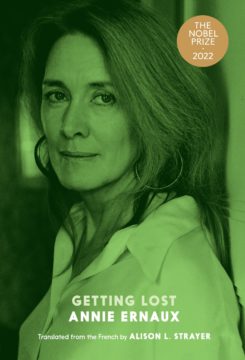 What a time to be reading about Annie Ernaux’s self-obliterating affair with S from the Soviet embassy in Paris, not that you’d sense that something’s in the air from the English-language reception to Getting Lost, Ernaux’s diary of the relationship, published in English last September. In the diary and in its generally admiring reviews S is described as a diplomat, apparatchik, attaché, ‘faithful servant of the USSR’ (Ernaux) and Brezhnev nostalgic/Stalin apologist when drunk. Also: ‘He is somewhat, not to say very, anti-Semitic: “Isn’t Mitterrand Jewish?” ’ Pretty standard stuff. Come on. He would have been KGB. And it matters not because he may or mayn’t have tried recruiting Ernaux – S kept their affair secret and appeared uninterested in converting her into an asset or using her connections (his anti-intellectualism was a turn-on for Ernaux). It’s possible in fact Ernaux was so erotically dazzling she shortcircuited, without realising, some good old planned sexual espionage (if so I’d like to read about it). She though wasn’t remotely intrigued by what S did when not with her: ‘I never knew anything about his activities, which, officially, were related to culture. Today, I am amazed that I did not ask more questions.’ Culture my arse. The KGB thing matters because an account of a prominent French writer, one of the greats to many, the most recent Nobel Prize winner losing her mind over a KGB stooge in the dying days of the Soviet Union reads, lands, sits, sticks, whatever the verb, differently after 24 February 2022.
What a time to be reading about Annie Ernaux’s self-obliterating affair with S from the Soviet embassy in Paris, not that you’d sense that something’s in the air from the English-language reception to Getting Lost, Ernaux’s diary of the relationship, published in English last September. In the diary and in its generally admiring reviews S is described as a diplomat, apparatchik, attaché, ‘faithful servant of the USSR’ (Ernaux) and Brezhnev nostalgic/Stalin apologist when drunk. Also: ‘He is somewhat, not to say very, anti-Semitic: “Isn’t Mitterrand Jewish?” ’ Pretty standard stuff. Come on. He would have been KGB. And it matters not because he may or mayn’t have tried recruiting Ernaux – S kept their affair secret and appeared uninterested in converting her into an asset or using her connections (his anti-intellectualism was a turn-on for Ernaux). It’s possible in fact Ernaux was so erotically dazzling she shortcircuited, without realising, some good old planned sexual espionage (if so I’d like to read about it). She though wasn’t remotely intrigued by what S did when not with her: ‘I never knew anything about his activities, which, officially, were related to culture. Today, I am amazed that I did not ask more questions.’ Culture my arse. The KGB thing matters because an account of a prominent French writer, one of the greats to many, the most recent Nobel Prize winner losing her mind over a KGB stooge in the dying days of the Soviet Union reads, lands, sits, sticks, whatever the verb, differently after 24 February 2022.
More here.
Research suggests prison accelerates the aging process and may be a factor in falling U.S. life expectancy
Fred Clasen-Kelly in Undark:
 Life expectancy fell in the United States in 2021 for the second year in a row, according to the Centers for Disease Control and Prevention. That decline is linked to the devastating effect of Covid-19 and a spike in drug overdoses.
Life expectancy fell in the United States in 2021 for the second year in a row, according to the Centers for Disease Control and Prevention. That decline is linked to the devastating effect of Covid-19 and a spike in drug overdoses.
Some academic experts and activists said the trend also underscores the lasting health consequences of mass incarceration in a nation with roughly 2 million imprisoned or jailed people, one of the highest rates in the developed world.
A Senate report last year found the U.S. Department of Justice failed to identify more than 900 deaths in prisons and local jails in fiscal year 2021. The report said the DOJ’s poor data collection and reporting undermined transparency and congressional oversight of deaths in custody.
More here.
Sugar, Slavery, and Capitalism: On Ulbe Bosma’s “The World of Sugar”
Dinyar Patel in the Los Angeles Review of Books:
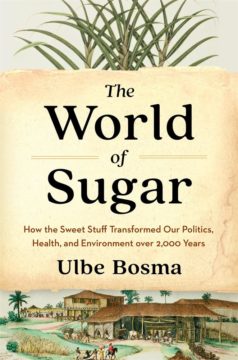 WHAT MIGHT DONALD RUMSFELD have in common with Frederick Barbarossa, Mormons, and Queen Elizabeth I’s rotting teeth? The answer is simpler than you might expect: the power and influence of sugar, a crystalline specimen of world-historical significance dissolved in your morning coffee or tea. A warmongering neocon, a Holy Roman emperor, pious Utahns, and a heavily cavitied pair of Tudor gnashers are part of an expansive cast of characters in Ulbe Bosma’s new work on the sweet stuff, The World of Sugar: How the Sweet Stuff Transformed Our Politics, Health, and Environment over 2,000 Years. This book is a tour de force of global history, one that helps us better understand the genesis of both modern capitalism and globalization.
WHAT MIGHT DONALD RUMSFELD have in common with Frederick Barbarossa, Mormons, and Queen Elizabeth I’s rotting teeth? The answer is simpler than you might expect: the power and influence of sugar, a crystalline specimen of world-historical significance dissolved in your morning coffee or tea. A warmongering neocon, a Holy Roman emperor, pious Utahns, and a heavily cavitied pair of Tudor gnashers are part of an expansive cast of characters in Ulbe Bosma’s new work on the sweet stuff, The World of Sugar: How the Sweet Stuff Transformed Our Politics, Health, and Environment over 2,000 Years. This book is a tour de force of global history, one that helps us better understand the genesis of both modern capitalism and globalization.
More here.
The myth of value-free science
Melanie Challenger at IAI News:
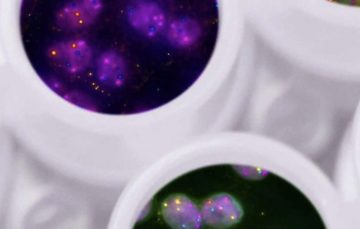 We demand a lot from scientists. They are required to be objective, rigorous, and accurate, and to conduct their work free from the constraints of religion or politics. Few other areas of human endeavour are expected to be or valued as being so free from human error. At the same time, scientists are tasked with assessing and considering the potential consequences and applications of their work, and to act responsibly to maintain public trust in their whole system of knowledge. That is a burden that scientists must feel acutely today, as they come under attack from the instruments of misinformation.
We demand a lot from scientists. They are required to be objective, rigorous, and accurate, and to conduct their work free from the constraints of religion or politics. Few other areas of human endeavour are expected to be or valued as being so free from human error. At the same time, scientists are tasked with assessing and considering the potential consequences and applications of their work, and to act responsibly to maintain public trust in their whole system of knowledge. That is a burden that scientists must feel acutely today, as they come under attack from the instruments of misinformation.
So valued is science as an objective arbiter of reality that the freedoms of scientists are seen as a measure of an enlightened society. And yet scientific knowledge has given the world Zyklon B as well as Penicillin. As such, publics often fear science as much as they demand its boons. So, how can we better steer science towards social good? And should scientists be held responsible for the implications of their work?
More here.
Kingsley Amis, The Art of Fiction
Michael Barber in The Paris Review:
 Kingsley Amis, the former Angry Young Man, lives in a large, early-nineteenth-century house beside a wooded common. To reach it, one makes a journey similar to that described by the narrator of Girl, 20 when he visits Sir Roy Vandervane: first by tube to the end of the Northern Line at Barnet; then, following a phone call from the station to say where one is, on foot up a stiff slope; and finally down a suburban road. But instead of being picked up en route by Sir Roy’s black chum, Gilbert, I was intercepted by Amis’s tall and imposing blond wife, the novelist Elizabeth Jane Howard.
Kingsley Amis, the former Angry Young Man, lives in a large, early-nineteenth-century house beside a wooded common. To reach it, one makes a journey similar to that described by the narrator of Girl, 20 when he visits Sir Roy Vandervane: first by tube to the end of the Northern Line at Barnet; then, following a phone call from the station to say where one is, on foot up a stiff slope; and finally down a suburban road. But instead of being picked up en route by Sir Roy’s black chum, Gilbert, I was intercepted by Amis’s tall and imposing blond wife, the novelist Elizabeth Jane Howard.
Amis’s study was a picture of bohemian disorder. Scattered across the floor were several teetering piles of poetry books and a mass of old 78 r.p.m. jazz records, while the big Adler typewriter on his desk was almost hidden behind a screen of empty bottles of sparkling wine which he’d recently sampled in his capacity as drink correspondent for Penthouse. A more sober note was struck by some shelves containing a complete Encyclopaedia Britannica, a thirteen-volume O.E.D., and various other authoritative tomes, but this was quickly dispelled by the sight of a small sherry cask in one corner, full, I was told, of whiskey.
More here.
Martin Amis, Acclaimed Author of Bleakly Comic Novels, Dies at 73
Dwight Garner in The New York Times:
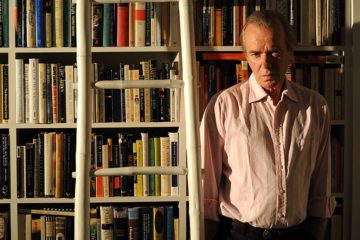 Martin Amis, whose caustic, erudite and bleakly comic novels redefined British fiction in the 1980s and ’90s with their sharp appraisal of tabloid culture and consumer excess, and whose private life made him tabloid fodder himself, died on Friday at his home in Lake Worth, Fla. He was 73.
Martin Amis, whose caustic, erudite and bleakly comic novels redefined British fiction in the 1980s and ’90s with their sharp appraisal of tabloid culture and consumer excess, and whose private life made him tabloid fodder himself, died on Friday at his home in Lake Worth, Fla. He was 73.
His wife, the writer Isabel Fonseca, said the cause was esophageal cancer — the same disease that killed his close friend and fellow writer Christopher Hitchens in 2011.
Mr. Amis published 15 novels, a well-regarded memoir (“Experience,” in 2000), works of nonfiction, and collections of essays and short stories. In his later work he investigated Stalin’s atrocities, the war on terror and the legacy of the Holocaust. He is best known for his so-called London trilogy of novels — “Money: A Suicide Note” (1985), “London Fields” (1990) and “The Information” (1995) — which remain, along with his memoir, his most representative and admired work.
More here.
Andy Rourke (1964 – 2023) Bass Player
Sunday Poem
Story
A woman’s taking her late afternoon walk
on Chestnut where no sidewalk exists
and houses with gravel driveways
sit back among the pines. Only the house
with the vicious dog is close to the road.
An electric fence keeps him in check.
When she comes to that house, the woman
always crosses to the other side.
I’m the woman’s husband. It’s a problem
loving your protagonist too much.
Soon the dog is going to break through
that fence, teeth bared, and go for my wife.
She will be helpless. I’m out of town,
helpless too. Here comes the dog
like one of those teenagers who just loses it
on the playground, kills the teacher.
Something’s going to happen that can’t happen
in a good story: out of nowhere a car
comes and kills the dog. The dog flies
in the air, lands in a patch of delphiniums.
My wife is crying now. The woman who hit
the dog has gotten out of her car. She holds
both hands to her face. The woman who owns
the dog has run out of the house. Three women
crying in the street, each for different reasons.
All of this is so unlikely; it’s as if
I’ve found myself in a country of pure fact,
miles from truth’s more demanding realm.
When I listened to my wife’s story on the phone
I knew I’d take it from her, tell it
every which way until it had an order
and a deceptive period at the end. That’s what
I always do in the face of helplessness,
make some arrangements if I can.
Praise the odd, serendipitous world.
Nothing I’d be inclined to think of
would have stopped that dog.
Only the facts saved her.
by Stephen Dunn
from Different Hours
W.W. Norton Company, 2000
Slava Zaitsev (1938 – 2023) Fashion Designer
Larry Mahan (1943 – 2023) Rodeo Cowboy
https://www.youtube.com/watch?v=VJlLRm2IvaU&ab_channel=MyRetroShare
Saturday, May 20, 2023
A photo essay to mark the 75th anniversary of the Nakba
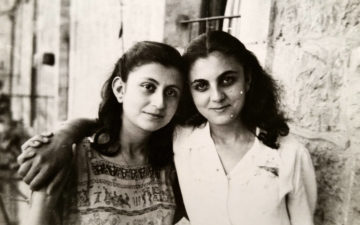 Nadia Saah in Jewish Currents:
Nadia Saah in Jewish Currents:
THIS PHOTOGRAPH IS OF MY MOTHER NINA, on the left. Her given name was Therese Yousef Saad, but her family called her Theresina because she was tiny and adorable—and she remained that way until her death in 2017. She is standing next to her cousin Leila on the balcony of her family’s home in Jerusalem. It is 1947, and she is engaged to my father Issa. (They would not marry until 1963. But that’s another story.) The photo conveys a deep intimacy: my mother’s easy grip on Leila’s hand; their closeness; the depth and warmth of my mom’s almond eyes. She is looking right at you, and at me. She is letting us in.
One year later, the Nakba ended her life in Palestine. I know that my mom and her family fled on a truck to As-Salt, Jordan, in May of 1948, and for a year and a half the six of them—she and her mother Lily, her father Yousef, her sisters Diana and Irma, and her baby brother Mattia—lived together in one room, over a barn. I know that on their first night they cried as they ate their dinner on the floor. And that the walls shook every time a horse kicked below them. I know that my mother prayed for their return to Jerusalem, until the day that she climbed the tallest hill in As-Salt to witness the waves of Palestinian refugees walking toward her with their belongings on their backs.
I will never know the full extent of what happened to my mother in the Nakba, but I can tell you that during the 47 years that I knew her, I never once saw this look in her eyes.
More here.
Green Capitalism and the Pitfalls of Climate Finance
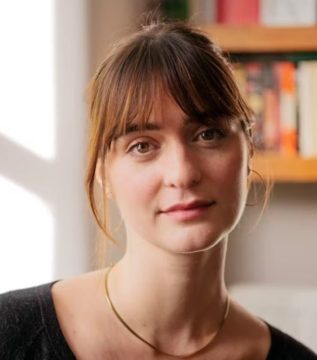 An interview with Adrienne Buller over at The Syllabus:
An interview with Adrienne Buller over at The Syllabus:
What is green capitalism and what are its goals and aspirations? Who are its cheerleaders, both in terms of institutions and actual individuals?
At its core, green capitalism is about rendering our response to climate and ecological crisis into a form that is compliant with market-based mechanisms. That sounds very simple. That is fundamentally all it really is. But how it plays out is often messier than it sounds.
Green capitalism is about finding a way to wedge all of the complexity of addressing climate and ecological crisis through the prism of the market. That requires finding prices for things, whether carbon or other forms of natural capital, and finding ways to adjust our financial modeling. The market seeks to bring forward neutral arbitration between market actors in pursuit of profit, and then views this as somehow inherently aligned with positive outcomes like curbing emissions or addressing biodiversity loss.
My first experience with green capitalism came from working at a nonprofit that helped private financial firms optimize their role in the green transition. The sustainable finance industry was a window into this clear mindset about how to address climate and ecological crisis: by making small, market-led tweaks, and by resisting the supposed messiness of politics.
Its advocates are everywhere. The finance industry itself is, in my view, the vanguard of this idea. You’ve got champions like Larry Fink, the CEO of BlackRock, as the poster child. But it’s also present in all kinds of European climate governance. The EU’s Green Deal is an archetypal policy program of green capitalism. As is the Inflation Reduction Act (IRA) in the US, which tries to crowd in market actors and find ways to make climate investments desirable for the private sector and its clients. It really is the predominant framework with which most policymakers, at least in the Global North, are forging ahead.
More here.
Is Multiculturalism an Oxymoron? On Martin Puchner’s “Culture”
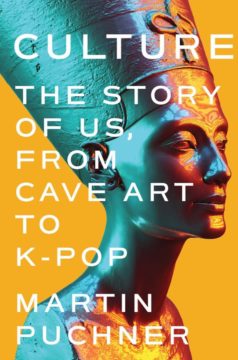 Robert N. Watson in LA Review of Books:
Robert N. Watson in LA Review of Books:
IN VERMONT, 25 years ago, I walked past a business whose sign read, “Amalgamated Culture Works.” My first thought was, “No, it doesn’t.”
Martin Puchner thinks it does—and explains why in his wonderful new book. Culture: The Story of Us, from Cave Art to K-pop deploys the histories of a vast range of times and places to convince our culture-warring world that amalgamation can work very well. The “us” of the subtitle signals Puchner’s intention: in an era of atomizing identity politics, deployed by both the radical left and right, he wants readers to recognize the many historical instances when cross-cultural transmission has been—and still can be—beneficial, rather than larcenous or contaminating.
A twofold thesis unifies the book. One is that the leftist ban on “cultural appropriation” entails a misunderstanding of the way cultures can appreciate (in both senses) when they meet, rather than merely collide. This seems true: if I think your dinner order looks excellent, and therefore decide to order the same menu item, that is very different from sticking my fork into your plate and gobbling a chunk of your entrée. Puchner’s other thesis is that the conservative aversion to immigration and multiculturalism whitewashes the wonderfully multicolored patchwork of human history. He shows that those who reach across cultures can be heroic rather than invasive, arrogant, or exploitative.
The “story” part of the subtitle matters almost as much as the “us” part. Puchner vividly recounts many times when the importation of a foreign story has positively transformed a culture.
More here.
Interrogating the Complexities of the Tumor Microenvironment
Alison Halliday in The Scientist:
 Cancer cells don’t exist in isolation – instead, they live within a complex ecosystem that also includes immune cells, stromal cells, the extracellular matrix, blood vessels and many other factors. The components of the tumor microenvironment constantly interact and influence each other, which can affect tumor behavior in either positive or negative ways.
Cancer cells don’t exist in isolation – instead, they live within a complex ecosystem that also includes immune cells, stromal cells, the extracellular matrix, blood vessels and many other factors. The components of the tumor microenvironment constantly interact and influence each other, which can affect tumor behavior in either positive or negative ways.
“Tumor cells can take advantage of their surrounding microenvironment – by co-opting nutrients and blocking immune surveillance and the host response. But importantly, the tumor microenvironment can also curtail tumor growth and prevent metastasis,” says Janis Taube, professor of dermatology and pathology and co-director of the Mark Foundation for Advanced Genomics and Imaging at Johns Hopkins University, Baltimore. “It’s a double-edged sword – and so it’s all about getting the balance right and trying to tip it more in favor of the host than the tumor.”
Given the diversity of cell types and molecules that form the tumor microenvironment, it is necessary to apply a systems biology approach to study it.
More here.
Trump the Defamer
Rafia Zakaria in The Baffler:
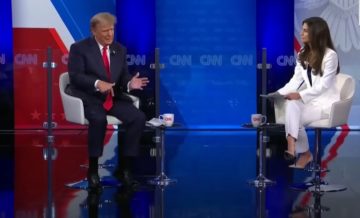 THE DAY AFTER a Manhattan jury held Donald J. Trump liable for sexually abusing and defaming writer E. Jean Carroll nearly three decades earlier, the former president came out swinging on a CNN broadcast from St. Anselm College in New Hampshire. “She’s a whack job,” he said. “This is a fake story, a made-up story,” he insisted. The paltry bit of feminist satisfaction I and millions of other American women had felt when the verdict came down suddenly seemed transitory. How much of a victory was the verdict if the perpetrator could come out with statements like this mere hours after it was delivered?
THE DAY AFTER a Manhattan jury held Donald J. Trump liable for sexually abusing and defaming writer E. Jean Carroll nearly three decades earlier, the former president came out swinging on a CNN broadcast from St. Anselm College in New Hampshire. “She’s a whack job,” he said. “This is a fake story, a made-up story,” he insisted. The paltry bit of feminist satisfaction I and millions of other American women had felt when the verdict came down suddenly seemed transitory. How much of a victory was the verdict if the perpetrator could come out with statements like this mere hours after it was delivered?
The jury of six men and three women had awarded Carroll $5 million in damages, including almost $3 million for the reputational damage she suffered by the former president’s public statements against her. Another $2 million was awarded because the jury believed the evidence that Trump had sexually abused Carroll at an encounter at a department store in New York City. Appearing on MSNBC, Carroll called the verdict a victory for all women because “we did away with the perfect victim concept.” That imaginary perfect victim, Carroll added, “always screams” and “writes the date in her diary.”
More here.
Bruno Schulz Biography
Joe Moshenska at The Guardian:
 Reading Schulz’s works, it’s easy to see why he might have had such an effect on this array of creative minds. His stories defy description, explication, paraphrase. They are set in a phantasmagoric version of the city of Drohobycz (now in western Ukraine), where Schulz was born and died, and largely in and around the cloth shop on the market square that his parents owned, but in a version of these places where time and space have become molten and malleable. They take place in “years which – like a sixth, smallest toe – grow a 13th freak month” in “an illegal time… liable to all kinds of excesses and crazes”. The narrator’s father – a looming, manic, tragicomic version of Schulz’s own – at one point wastes away to nothing, leaving only “the small shroud of his body” and “a handful of nonsensical oddities”; at another he morphs into “a monstrous, hairy, steel blue horsefly”, a development that the narrator takes in his stride as just one of many “summer aberrations”. The stories read like the quintessence of the human imagination in its densest, strangest form, as if his language were a thick, sweet concentrate of the creativity that other writers dilute to a sippable weakness.
Reading Schulz’s works, it’s easy to see why he might have had such an effect on this array of creative minds. His stories defy description, explication, paraphrase. They are set in a phantasmagoric version of the city of Drohobycz (now in western Ukraine), where Schulz was born and died, and largely in and around the cloth shop on the market square that his parents owned, but in a version of these places where time and space have become molten and malleable. They take place in “years which – like a sixth, smallest toe – grow a 13th freak month” in “an illegal time… liable to all kinds of excesses and crazes”. The narrator’s father – a looming, manic, tragicomic version of Schulz’s own – at one point wastes away to nothing, leaving only “the small shroud of his body” and “a handful of nonsensical oddities”; at another he morphs into “a monstrous, hairy, steel blue horsefly”, a development that the narrator takes in his stride as just one of many “summer aberrations”. The stories read like the quintessence of the human imagination in its densest, strangest form, as if his language were a thick, sweet concentrate of the creativity that other writers dilute to a sippable weakness.
more here.
Saturday Poem
Sure There Is Food
There is eating one’s self
There is even truth now and then—
Of course a lie can be made to go
Farther that way
The trick is to get truth and lies
To sound just the same
That way you’ve got it made
Everybody is mad after a while
Then you can come up with a world
where madness is the normal thing
Of course those who rig it that way
End up mad themselves
But—who’s to know the difference?
This world’s the best example I know
by Kenneth Patchen
from Collected Poems, 1968
From War To Music
Dwight Garner at the New York Times:
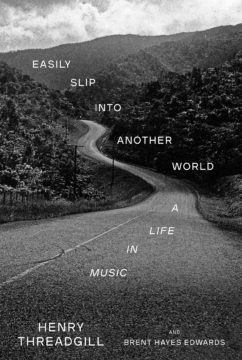 It’s rare to come across a new Vietnam War memoir from a major publisher in 2023. Most were written decades ago, when memories were fresh and wounds still raw. That generation of soldiers has begun to pass away.
It’s rare to come across a new Vietnam War memoir from a major publisher in 2023. Most were written decades ago, when memories were fresh and wounds still raw. That generation of soldiers has begun to pass away.
Henry Threadgill’s “Easily Slip Into Another World” is an unusual entrant in the genre. For one thing, this astringent book is only in part about his war experience. The remainder is about his rebellious childhood in Chicago during the 1950s, his apprenticeship in that city’s pyretic music scene and — later, after the war — his variegated career as a composer, saxophonist and flutist touring the world and becoming, along with Ornette Coleman and Wynton Marsalis, one of the few jazz artists to have won a Pulitzer Prize.
There’s more here than an insane war story, in other words.
more here.
